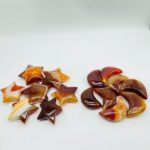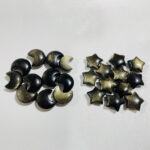Introduction: Unveiling the Enchanting World of Quartz Rutile
Quartz rutile, a captivating blend of quartz and rutile inclusions, captivates with its unique beauty and exceptional properties. Its crystalline form, adorned with golden rutile needles, has earned it the moniker “angel hair” or “Venus hair.” Beyond its captivating aesthetics, quartz rutile holds a wealth of scientific and technological significance, making it an object of fascination for scientists, artists, and collectors alike.

Geological Origins: A Journey through Time and Minerals
Quartz rutile is born from the depths of the Earth, where intense heat and pressure forge quartz crystals. As these crystals grow, tiny rutile needles, composed of titanium dioxide, become trapped within the quartz structure. The resulting gemstone showcases a stunning contrast between the transparent quartz and the golden-hued rutile inclusions, creating a mesmerizing visual spectacle.
Physical and Chemical Properties: Deciphering the Scientific Attributes
Quartz rutile possesses remarkable physical and chemical properties that contribute to its distinctive characteristics.
- Mohs Hardness: 7
- Specific Gravity: 2.65
- Crystal System: Trigonal
- Chemical Composition: SiO2 (quartz) + TiO2 (rutile)
Its hardness of 7 on the Mohs scale indicates that quartz rutile is a durable gemstone, resistant to scratches and wear. The specific gravity of 2.65 suggests that it is relatively lightweight, making it ideal for jewelry applications.
Optical Properties: Capturing the Play of Light
Quartz rutile exhibits extraordinary optical properties that enhance its visual appeal.
- Refractive Index: 1.54-1.55
- Birefringence: 0.009
The high refractive index of quartz rutile contributes to its brilliant luster and dispersion, which gives rise to the fiery play of colors known as “fire.” The birefringence, or double refraction, adds depth and complexity to the gemstone.
Quartz Rutile in Jewelry: Embracing Elegance and Symbolism
Quartz rutile’s captivating beauty has made it a popular choice for jewelry design.
- Clarity: Ranges from translucent to opaque
- Color: Varies from colorless to yellow, brown, orange, and pink
The translucent to opaque clarity of quartz rutile allows light to diffuse through the stone, highlighting the intricate patterns of rutile inclusions. Its versatile color palette complements a wide range of jewelry styles, from delicate pendants to bold statement pieces.
Scientific Applications: Exploring the Practical Utility
Beyond its aesthetic appeal, quartz rutile holds significant scientific value.
- Laser Technology: The high refractive index and birefringence of quartz rutile make it a crucial component in laser technology.
- Sensors: Quartz rutile’s piezoelectric properties enable its use in sensors for pressure, vibration, and temperature measurement.
- Optics: The optical properties of quartz rutile find application in optical fibers, lenses, and prisms.
- Medical Applications: Researchers are exploring the potential of quartz rutile in medical imaging and cancer detection.
Motivations and Pain Points: Understanding the Market Landscape
The demand for quartz rutile is driven by various motivations and pain points experienced by consumers and industries.
Motivations:
– Desire for unique and captivating gemstones
– Appreciation of the gemstone’s durability and resistance to wear
– Interest in its scientific and technological applications
Pain Points:
– Limited availability of high-quality quartz rutile
– Potential for confusion with synthetic or treated gemstones
– Lack of standardized grading criteria
Pros and Cons: Weighing the Advantages and Disadvantages
Pros:
– Stunning beauty and visual appeal
– Durable and resistant to scratches and wear
– Versatile color palette suitable for a wide range of jewelry styles
– Possesses unique scientific and technological properties
Cons:
– Limited availability
– Potential for color fading in prolonged exposure to sunlight
– May require specialized care and cleaning to maintain its luster
FAQs: Providing Answers to Common Questions
-
What is the difference between quartz rutile and titanium quartz?
* Quartz rutile contains natural rutile inclusions, while titanium quartz is treated with titanium to create a similar appearance. -
How do I care for quartz rutile jewelry?
* Clean gently with mild soap and water. Avoid harsh chemicals or ultrasonic cleaners. -
Is quartz rutile a valuable gemstone?
* High-quality quartz rutile can be valuable, especially for collectors and jewelry enthusiasts. However, its value varies based on factors such as clarity, color, and carat weight. -
What is the Mohs hardness of quartz rutile?
* Quartz rutile has a Mohs hardness of 7, making it relatively resistant to scratches and wear. -
Can quartz rutile be used in laser technology?
* Yes, quartz rutile’s high refractive index and birefringence make it a valuable component in laser systems. -
What is the chemical composition of quartz rutile?
* Quartz rutile is composed of silicon dioxide (SiO2) and titanium dioxide (TiO2). -
Is quartz rutile naturally radioactive?
* In general, no. Quartz rutile is not naturally radioactive. -
What is the typical color of quartz rutile?
* Quartz rutile typically ranges in color from colorless to yellow, brown, orange, and pink.
Conclusion: Celebrating the Wonder of Quartz Rutile
Quartz rutile stands as a testament to nature’s artistry and scientific ingenuity. Its captivating beauty and extraordinary properties have captivated humans for centuries, inspiring both awe and innovation. As technology advances and new applications are discovered, quartz rutile continues to reveal its multifaceted nature, promising to unlock further wonders in the realm of science and art. Embracing its captivating allure and practical value, we invite you to delve deeper into the enigmatic world of quartz rutile.
Tables for Reference
Table 1: Physical and Chemical Properties of Quartz Rutile
| Property | Value |
|---|---|
| Mohs Hardness | 7 |
| Specific Gravity | 2.65 |
| Crystal System | Trigonal |
| Chemical Composition | SiO2 (quartz) + TiO2 (rutile) |
Table 2: Optical Properties of Quartz Rutile
| Property | Value |
|---|---|
| Refractive Index | 1.54-1.55 |
| Birefringence | 0.009 |
Table 3: Scientific Applications of Quartz Rutile
| Application | Industry |
|---|---|
| Laser Technology | Electronics |
| Sensors | Aerospace, Automotive, Medical |
| Optics | Telecommunications, Healthcare |
| Medical Imaging | Healthcare |
Table 4: Care and Maintenance for Quartz Rutile
| Care | Frequency |
|---|---|
| Gentle Cleaning with Mild Soap and Water | As needed |
| Avoid Harsh Chemicals and Ultrasonic Cleaners | N/A |
| Store in a Soft, Protected Place | N/A |
| Have Professionally Cleaned by a Jeweler | Annually or as needed |




























